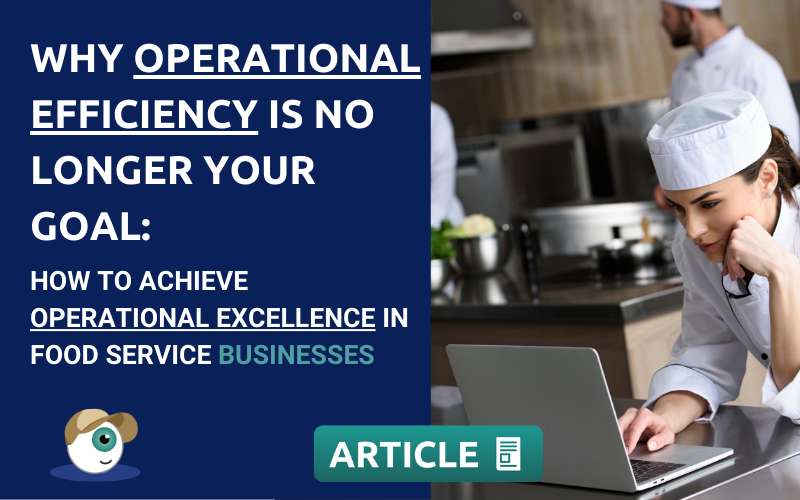Why Operational Efficiency is no longer your goal: How to achieve Operational Excellence in Food Service Businesses
The foodservice industry is a cutthroat battleground where razor-thin profit margins and intense competition are the norm.
Soaring costs, demanding customers, and complex regulations create a perfect storm that can sink even the most promising ventures.
With a staggering 30% of restaurants closing within the first year of operation, survival (and success!) demands more than just efficiency.
While operational efficiency is crucial for survival, today it’s no longer enough to thrive.
To truly excel, you must go beyond efficiency and strive for operational excellence in food service businesses.
But what exactly do these terms mean, what is their difference, and how can they be leveraged to drive growth and profitability?
Find out more in this post!
What is Operational Efficiency?
Operational efficiency in the food service industry refers to the optimisation of processes and resource allocation to maximise output while minimising waste and costs.
It’s about streamlining operations from the kitchen to the front of the house, ensuring every aspect of the business runs smoothly and productively.
What are the key components of operational efficiency?
- Inventory management: Precisely balancing stock levels to avoid shortages or surpluses.
- Labor schedulling: Optimising staff schedules to match customer demand.
- Kitchen layout and workflow: Designing efficient kitchen spaces and processes to expedite food preparation.
- Technology integration: Leveraging technology to automate tasks and gather data for analysis.
There’s no doubt that by focusing on these areas, food service operators can significantly improve their bottom line and free up resources for growth.
But, is it enough?
Not quite. Not today.
Operational Excellence in Food Service Businesses
While operational efficiency is a critical foundation for any successful food service business, it’s merely the starting point.
To truly excel, it’s vital to elevate operations to achieve operational excellence in food service businesses. This involves a holistic approach that prioritises customer satisfaction, employee engagement, data-driven decision-making, and continuous improvement.
Customer Centricity
At the heart of operational excellence in food service businesses is a deep-rooted commitment to the customer experience.
This involves:
- Understanding customer needs and preferences: Conducting thorough market research and customer feedback analysis.
- Personalisation: Tailoring products and services to meet individual customer expectations.
- Service excellence: Delivering exceptional customer service at every touchpoint.
- Building customer loyalty: Implementing loyalty programs and creating memorable experiences.
Employee Engagement
A high-performing team is essential for operational excellence in food service businesses. By fostering a positive and supportive work environment, food service businesses can:
- Improve employee satisfaction: Offering competitive wages, benefits, and opportunities for growth.
- Enhance employee engagement: Empowering employees to make decisions and contribute ideas.
- Reduce turnover: Investing in employee development and creating a strong company culture.
- Foster teamwork and collaboration: Building a cohesive team environment.
Data-Driven Decision Making
Leveraging data is crucial for identifying areas of improvement and optimising operations. Key metrics to track include:
- Customer satisfaction: Measuring customer feedback and net promoter scores (NPS).
- Financial performance: Analysing sales, costs, and profitability.
- Operational efficiency: Tracking metrics such as labour costs, food waste, and inventory turnover.
- Employee performance: Evaluating employee satisfaction, productivity, and turnover.
By harnessing the power of data, food service operators can make informed decisions, allocate resources effectively, and drive continuous improvement.
Continuous Improvement
Operational excellence is an ongoing journey, not a destination. A culture of continuous improvement is essential for staying ahead of the competition. This involves:
- Identifying opportunities for improvement: Conducting regular process reviews and seeking employee input.
- Implementing change: Piloting new ideas and measuring their impact.
- Learning from failures: Analysing setbacks to identify lessons learned.
- Celebrating successes: Recognising and rewarding achievements.
By embracing a culture of continuous improvement, food service businesses can adapt to changing market conditions, exceed customer expectations, and achieve long-term success.
Why Operational Efficiency Isn’t Enough
While operational efficiency is undoubtedly crucial for the survival of any food service business, it’s no longer a sufficient differentiator in today’s highly competitive market.
Simply doing things faster or cheaper is no longer enough to captivate customers or drive sustainable growth.
The modern consumer demands more than just speed and affordability; they seek exceptional experiences, personalised service, and a strong brand identity. A focus solely on efficiency can lead to a commoditised offering, making it difficult to stand out from the crowd.
To thrive in this dynamic environment, you must shift your focus from efficiency to excellence.
By prioritising customer satisfaction, cultivating a high-performance culture, and harnessing data-driven insights, you can build a strong foundation for long-term success.
In essence, operational efficiency is a prerequisite for operational excellence in food service business, but it is not synonymous with it. True success lies in creating a seamless customer journey, empowering employees, and continuously improving processes.
Automation: The Key to Operational Excellence in Food Service Businesses
By automating routine tasks and leveraging technology, restaurants can unlock a multitude of benefits that drive efficiency, accuracy, and ultimately, customer satisfaction.
Here are some examples of how automation is revolutionising foodservice operations today:
Inventory Management:
Gone are the days of manual stock checks and guesswork!
Automated inventory management systems use real-time data to track stock levels, predict demand, and optimise ordering. This translates to reduced food waste, lower labour costs, and a consistent supply of essential ingredients.
Point-of-Sale (POS) Systems
Modern POS systems are much more than just cash registers. They streamline order taking, payment processing, and customer data management.
This not only accelerates service but also unlocks valuable insights into customer preferences, leading to targeted marketing campaigns and a more personalised experience.
Kitchen Display Systems (KDS)
These digital dashboards display orders clearly and efficiently, minimising errors and ensuring smooth food preparation workflows.
This leads to faster order turnaround times and a more predictable dining experience for customers.
Predictive Analytics
Data has become the lifeblood of successful businesses. Predictive analytics software analyses past sales data, weather patterns, and even social media trends to forecast demand.
This allows restaurants to optimise staffing levels, adjust menu offerings based on seasonal preferences, and identify potential issues before they become disruptions.
The benefits of automation extend beyond just increased efficiency.
Numerous studies, including one by the National Restaurant Association, show that embracing advanced technologies like mobile ordering and payment systems can lead to significant growth. These studies report average sales increases of 5-10% and potential labour cost reductions of up to 20%.
Ultimately, automation frees staff from tedious tasks, allowing them to focus on higher-value activities like interacting with customers and delivering exceptional service. This translates into a more robust and competitive foodservice operation.
And what about kitchen operations?
What about food safety management?
Can operational excellence be achieved also in the more volatile kitchen environment?
Absolutely, with 🧢 Andy!
Andy: the Key to Achieving Operational Excellence in the Food Service Kitchen
A cornerstone of operational excellence in the foodservice kitchen lies in the effective management of food safety, quality, and efficiency.
Andy is instrumental in achieving these goals. Let us show you how:
HACCP Automation and Food Safety Labelling
By automating HACCP (Hazard Analysis and Critical Control Points) processes, Andy significantly enhances food safety.
Features such as digital checklists, automated temperature monitoring, and real-time alerts help to identify and mitigate risks. Additionally, Andy can automate food safety labelling, ensuring accurate and up-to-date information is displayed on products.
Digital Operational Checklists and Preventive Management
Digital checklists streamline routine tasks, ensuring consistency and compliance.
Andy can create custom checklists for various areas of the kitchen, including cleaning, equipment maintenance, and staff hygiene. By automating these processes, staff can focus on higher-value tasks, while the system tracks compliance and identifies areas for improvement.
Internal Communication and Incident Management
Effective communication is vital for a well-run kitchen. Andy can facilitate seamless communication between kitchen staff and management, ensuring everyone is informed and aligned.
Our food safety and operational excellence software can also be used to document and track incidents, allowing for efficient investigation and corrective actions.
Internal Auditing
Regular internal audits are essential for maintaining high standards. Andy can automate the audit process by creating digital checklists and collecting data on compliance. This streamlines the auditing process, identifies areas for improvement, and provides valuable insights for management.
By leveraging automation tools like Andy, you will significantly enhance your operational efficiency and create a foundation for operational excellence.
By streamlining processes, improving food safety, and empowering staff, Andy will create a safer, more productive, and customer-centric kitchen environment for your food service business.


